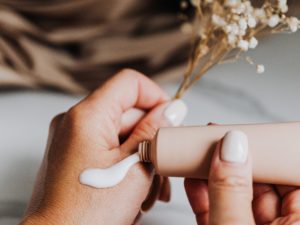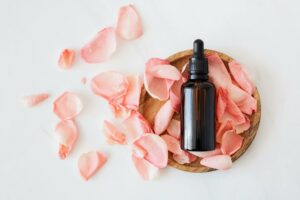Snail Mucin – Everything You Need to Know! Is the hype behind snail mucin fact or fiction?
Snail mucin is a skincare trend people either love completely or hate.

Are there any actual benefits to this weird skincare ingredient? Is it a really slimy and gross feeling product? What skin type can use it?
And maybe the most important question is, are snails harmed in the harvesting of the product?
Let’s fact-check snail mucin with science based articles and information.
Here is everything you need to know about snail mucin, from benefits to risks, and how to use it in your skincare routine!
What is Snail Mucin?
You know the secretion that snails produce when they move across the ground? Yeah, someone decided to bottle that and sell it.
Though it has become popular in recent years, it is not a new product. Snail mucin has been used for thousands of years historically and used in Asian skincare products for decades.
And it’s worked. The snail mucin industry is a 4 billion dollar industry, but does research support this product?
What are the Benefits of Snail Mucin?
There are many benefits to snail mucin as an ingredient in skincare. It is rich in humectants such as hyaluronic acid, meaning it will help hydrate the skin.
Research suggests it promotes healing and can be very beneficial in wound healing. One study found an increase in skin health with patients going through radiation treatment. This study has no conflict of interest, meaning the results are not biased and more believable.
Snail mucin is also high in collagen which will not increase collagen production in the skin, but it will increase hydration.
It can help calm skin and soothe inflammation due to high amounts of zinc and may reduce dark spots. The copper peptides found in the mucin do have a positive effect on fine lines and wrinkles as this does increase collagen and elasticity.
To extract it is a relatively inexpensive process, meaning products do not have to raise prices.
What Skin Type Can Use it?
Snail mucin is beneficial to any person with any skin type. How it reacts to the skin is usually determined by the formulation of the product. Serums and moisturizers with snail mucin might be suitable for dryer skin whereas essences and lotions might work better for oil-prone skin.
Individuals with rosacea, intense redness of the skin, sensitivity, and other skin conditions may benefit from the healing and soothing properties of this ingredient.
How to Use Snail Mucin in Skincare
Snail mucin in your skincare routine depends on the product formulation. A toner or essence with snail mucin should be used before serums and moisturizers.
Check out this complete guide to layering skincare today!
The Downside of Snail Mucin
Here are potential downsides to using snail mucin, so make sure to read this thoroughly before trying the product out!
Animal Use in Harvesting Snail Mucin
Historically, snail mucin was found when harvesting snails for consumption. In later years for the collection of mucin, companies would kill the snails to get the secretion. That was a decade ago.
Now, brands like Cosrx and many others, state they treat the snails ethically, leaving them to rest and move around in a calming room. Snails produce mucin when they are stressed, surprised, or extremely happy, so here’s hoping it’s the latter!
In theory, snails need to be kept happy as mucin from stressed snails would not be useful in skincare.
Potential Allergic Reaction of Snail Mucin
There may be potential to have an allergic reaction to snail mucin if you already have a mite allergy.
Unknown Percent of Snail Mucin in Products
It may be impossible to know how much snail mucin is in your product, as snail mucin filtrate can have more or less snail mucin depending on the method of extraction.
Snail mucin filtrate is the ingredient derived from snail mucin, but even a product with 96% snail mucin filtrate may have less actual mucin than a product with 60% snail mucin filtrate.
Texture of Snail Mucin
Some snail mucin products just feel tacky and sticky to some. This may be unpleasant for some as it creates a slime texture.
Newer products have learned to enhance the texture products however, either formulating with less snail mucin or using other ingredients to make the texture less, well, mucin-y.
More Studies Needed
While there have been some studies on the effects of snail mucin in humans, more research should be done to determine long-term effects. One study that found amazing benefits, was founded by a company selling a hundred-dollar snail mucin product, which is a conflict of interest.
One fun fact, one study has found a benefit in the oral intake of snail mucin, which can potentially reduce UVB absorption, increase hydration, and improve skin elasticity!
Personal Opinion
I personally do not mind the texture, it is hydrating, fun, and very soothing! I only use it in Cosrx products, as I know their products are completely cruelty-free and relatively inexpensive.
The texture of the snail mucin essence is very lightweight and absorbs easily, practically disappearing, whereas the all in one snail mucin cream is a bit heavier and more moisturizing, but it is still incredibly lightweight.
You can replace snail mucin with other products, such as plant-based peptides or hyaluronic acid so you can get the benefits without using animal products.
The Takeaway
Snail mucin seems to be a good ingredient if you can overlook the texture and process used to obtain it.
Snail mucin has many benefits such as reducing inflammation, soothing the skin, decreasing rosacea, and much more potential.
Research should continue, but anecdotal, snail mucin is great for promoting skin health and decreasing sensitivity. The properties it has may promote wound healing as well.
As with any skincare product, patch test it on the inside of the wrist and side of the neck to ensure you do not have a reaction to it! Remember, skin care is about progress, not perfection and skincare should never feel like a chore!
Enjoy the steps along the way of a healthy skin journey!





